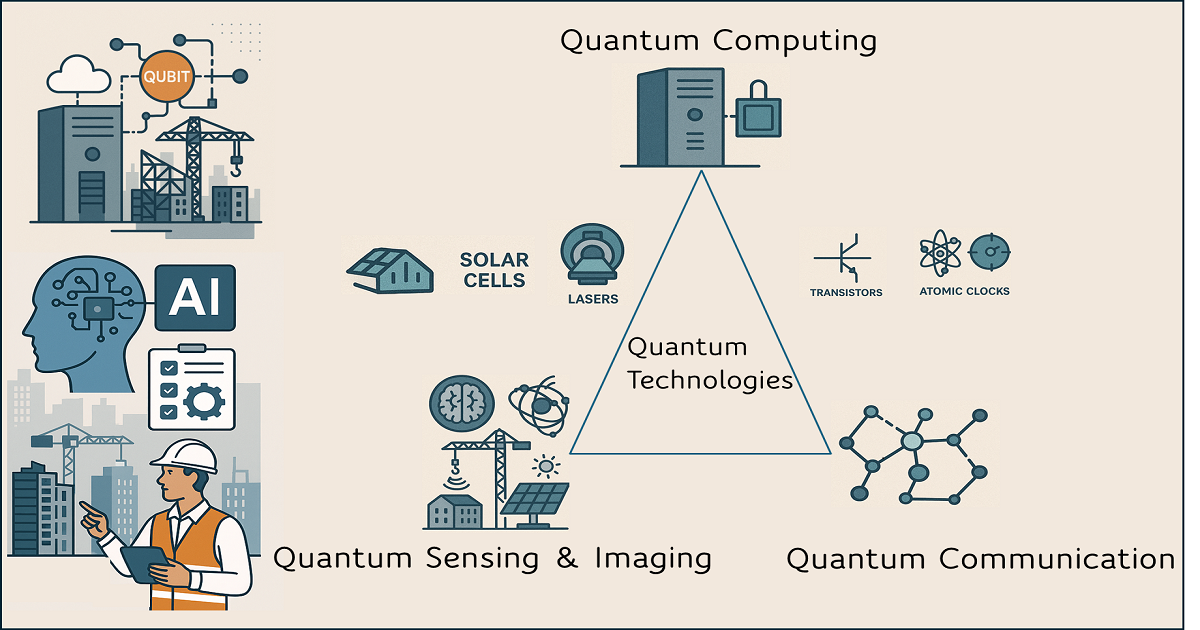Quantum and AI Technologies in Engineering and Construction Projects: Design Challenges and Opportunities
A special issue of Designs (ISSN 2411-9660). This special issue belongs to the section "Civil Engineering Design".
Deadline for manuscript submissions: 31 July 2026 | Viewed by 31

Special Issue Editors
Interests: construction management; project management; Six Sigma; risk management; quality management; digital built environment
Special Issue Information
Dear Colleagues,
The introduction of disruptive technologies is revolutionizing the engineering and construction (E&C) industry and associated project designs. From traditional technologies to Big Nine Techs and now quantum technologies, digital technologies have rewritten the rules of work and reshaped the modus operandi of projects in the E&C industry. E&C projects are inherently complex and dynamic, involving multiple interdependent systems, data flows, and decision layers that require advanced analytical and computational approaches. As the E&C industry faces rapid technological transformation, traditional methods of project design are becoming insufficient to capture the scale, uncertainty, and interconnectedness of modern E&C ecosystems. This complexity has created the need for emerging technologies, notably quantum computing and Artificial Intelligence (AI), to enhance how we design E&C projects and the associated modelling and optimization.
The ongoing global shift toward Industry 5.0 has accelerated the demand for intelligent, data-driven, and sustainable approaches to E&C project designs. Integrating quantum and AI technologies further amplifies both the opportunities and challenges facing the industry. These technologies enable more powerful computation, optimization, sensing, and communication capabilities, offering new ways to improve design precision and quality in uncertain E&C environments.
This Special Issue aims to gather high-quality contributions on Quantum and AI frontiers in E&C project design, including their challenges and opportunities. We invite submissions from researchers, professionals, and industry leaders in engineering, construction management, project management, digital design, and related fields. The submitted articles may explore a wide range of topics related to the role of quantum and AI technologies in transforming E&C project design and delivery, including but not limited to the following:
- Quantum computing for optimization of E&C project design.
- AI and machine learning for predictive design and performance analytics in the E&C industry.
- Quantum sensing, communication, and imaging in E&C project design.
- Digital twins, BIM, and data-driven ecosystems powered by quantum–AI integration for E&C project design.
- Quantum sensing and imaging for E&C infrastructure design, health monitoring, and geospatial analysis.
- Generative design and AI-driven decision-support systems for E&C project design.
- Machine learning and deep learning applications in E&C project design.
- AI-based risk prediction, scheduling, and cost forecasting of E&C project designs.
- Hybrid quantum–AI models for real-time E&C design optimization.
- Quantum machine learning for predictive E&C project design analytics.
- Quantum-enhanced reinforcement learning for E&C project control and design automation.
- Multi-objective quantum–AI frameworks for sustainable and resilient E&C project design.
- Opportunities for and barriers to the adoption of quantum and AI technologies in E&C project designs.
- Digital skills, education, and workforce transformation for E&C project design.
Dr. Siddra Qayyum
Dr. Mumtaz Ali
Guest Editors
Manuscript Submission Information
Manuscripts should be submitted online at www.mdpi.com by registering and logging in to this website. Once you are registered, click here to go to the submission form. Manuscripts can be submitted until the deadline. All submissions that pass pre-check are peer-reviewed. Accepted papers will be published continuously in the journal (as soon as accepted) and will be listed together on the special issue website. Research articles, review articles as well as short communications are invited. For planned papers, a title and short abstract (about 100 words) can be sent to the Editorial Office for announcement on this website.
Submitted manuscripts should not have been published previously, nor be under consideration for publication elsewhere (except conference proceedings papers). All manuscripts are thoroughly refereed through a single-blind peer-review process. A guide for authors and other relevant information for submission of manuscripts is available on the Instructions for Authors page. Designs is an international peer-reviewed open access semimonthly journal published by MDPI.
Please visit the Instructions for Authors page before submitting a manuscript. The Article Processing Charge (APC) for publication in this open access journal is 1600 CHF (Swiss Francs). Submitted papers should be well formatted and use good English. Authors may use MDPI's English editing service prior to publication or during author revisions.
Keywords
- quantum computing
- artificial intelligence (AI)
- engineering projects
- construction project design
- digital twins
- building information modelling (BIM)
- quantum sensing and communication
- lasers
- solar cells
- generative design
Benefits of Publishing in a Special Issue
- Ease of navigation: Grouping papers by topic helps scholars navigate broad scope journals more efficiently.
- Greater discoverability: Special Issues support the reach and impact of scientific research. Articles in Special Issues are more discoverable and cited more frequently.
- Expansion of research network: Special Issues facilitate connections among authors, fostering scientific collaborations.
- External promotion: Articles in Special Issues are often promoted through the journal's social media, increasing their visibility.
- Reprint: MDPI Books provides the opportunity to republish successful Special Issues in book format, both online and in print.
Further information on MDPI's Special Issue policies can be found here.





